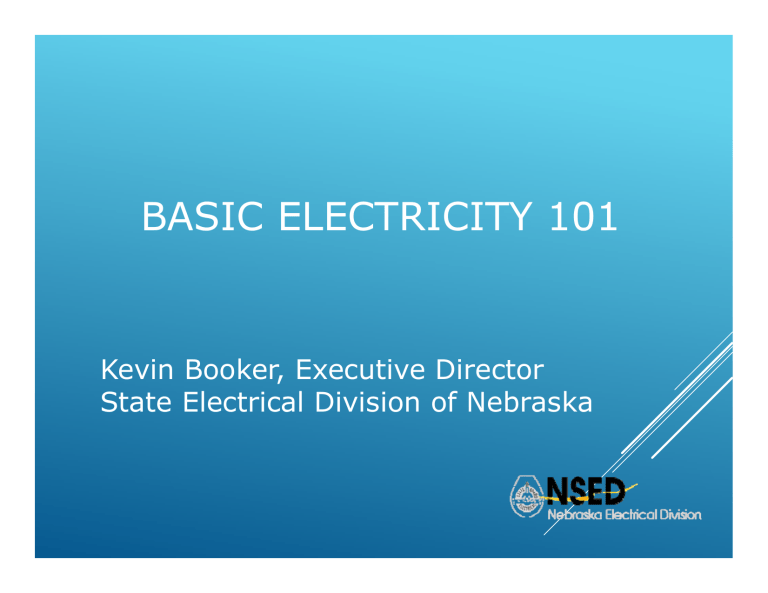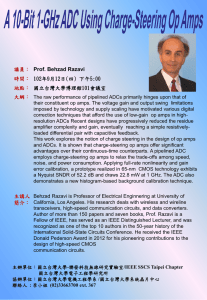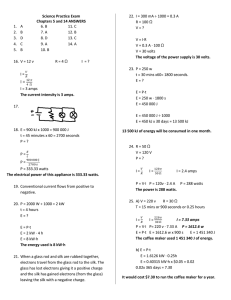BASIC ELECTRICITY 101 Kevin Booker, Executive Director State Electrical Division of Nebraska

BASIC ELECTRICITY 101
Kevin Booker, Executive Director
State Electrical Division of Nebraska
Review some typical hazards associated with electricity and learn how to mitigate the hazards.
OBJECTIVES
In the United States, electrical hazards are ranked number 6 among all causes of work-related deaths.
The following drawing shows how circuit breakers access the incoming power:
SINGLE PHASE ELECTRIC PANEL
ELECTRIC PANEL
Double Pole
Circuit Breaker
240v
240v Circuit
Neutral
Main Power
240v / 120v -1Ø
Main Breaker
Bus Bars
Single Pole
Circuit Breaker
120v
120v Circuit
Ground
So a 2000 watt UPS will draw how many amps?
2000/120 =16.66 amps
A standard 20 amps outlet is designed to carry 80%, that would be 16 amps.
How much additional load will this circuit handle?
I = V/R
Venting
Rated ?
Listed
NEC 110.13. Mounting and Cooling of
Equipment.
This requirement is always in dispute, it seems. Cramming equipment into an overcrowded arrangement to maximize revenue per square foot sounds like a really good idea until that equipment starts failing left and right, or the whole place just burns down.
NATIONAL ELECTRICAL CODE
Do YOU push the test button on GFCIs and AFCIs monthly?
It’s HARD to remember without calendaring the task!
NEC 110.3. Examination, Identification, and Use of Equipment. This section gives
8 requirements for examination in part
(A). In (B), it says "Listed or Labeled equipment shall be installed and used in accordance with any instructions included in the Listing or Labeling."
In other words, use the product as intended. Unauthorized modifications void the Listing and expose the modifier to civil, and potentially criminal, litigation and liability.
Back in 2005 the CPSC (Consumer
Product Safety Commission) went to the electrical manufacturers of GFCI’s and asked them to develop self testing devices.
The original scope was that the device would shut down if it did not pass the self test and hence create the safety that these devices are there to provide.
Section 1926.416(e)(1) provides that "worn or frayed electrical cords or cables shall not be used." Superficial nicks or abrasions — those that only slightly penetrate the outer jacket of a flexible cord, and do not permit the cord to bend more in that area than in the rest of the cord — do not normally render a cord "worn or frayed." Therefore, there is no need to repair or replace such a cord.
OSHA STANDARDS
Stapled through cord!
AMPACITY AND WIRE INSULATION
*According to the electrical code, the overcurrent protection shall not exceed 15A for #14, 20A for
#12, or 30A for #10
(However, insulation is a factor in locations above 86 F)
WIRE AND CIRCUIT BREAKER
SIZING FOR MOTOR LOADS
HAZARDS and RISKS
when working with
ELECTRICITY
What is the BEST WAY TO
PREVENT THE HAZARDS
of electricity?
AVOID energized circuits - the safest way!
THINK
before taking
Action
THINK
about the
Risks
and
Hazards
OPTIONS
Do you have options like:
LOTO (Lockout/Tagout)
PROTECTION
Are you wearing PPE?
(Personal Protective
Equipment)
WHAT are the
HAZARDS and RISKS?
1.
2.
3.
Shock
Arc Flash & Arc Blast
Fire Ignition
SHOCK AND ITS EFFECTS
Immediate:
1.
2.
Muscle contraction
Vital organs damaged
3.
4.
5.
Tingling
Pain
Breathing
6.
7.
8.
Disorientation
Dizziness
Possible death
SHOCK AND ITS EFFECTS
Long Term:
1.
Memory Loss
2.
3.
4.
5.
Nervous disorders
Chemical imbalances
Damage to vital organs
Sometimes fatal
EFFECT OF CURRENT ON THE BODY
MEN
Perception Threshold
0.001 Amps (1 mA)
Painful Shock
0.009 Amps (9 mA)
Cannot Let-Go Level
0.010 Amps (10 mA)
Ventricular Fibrillation
.100 Amps (100 mA)
Heart Failure
0.5 Amps (500 mA)
Organ Burn
1.5 Amps (1500 mA)
WOMEN
Perception Threshold
0.0007 Amps (0.7 mA)
Painful Shock
0.006 Amps (6 mA)
Cannot Let-Go Level
0.010 Amps (10 mA)
Ventricular Fibrillation
.100 Amps (100 mA)
Heart Failure
0.5 Amps (500 mA)
Organ Burn
1.5 Amps (1500 mA)
TWO TYPES OF
BURNS FROM SHOCK
Surface Burns:
Caused by entrance and exit of electrical currents through the body
Can be caused by a very small amount of current
1 st degree to 3 rd degree
ARC FLASH & BLAST
RELATIVE TO THE HUMAN BODY :
A 2 nd degree burn threshold, or a ‘just curable burn threshold,’ is skin temperature raised to 175 o F for 0.1 second.
A 3 rd degree burn threshold, or ‘incurable burn threshold,’ is skin temperature raised to 200 o F for 0.1 second.
Eardrum damage > 720 psf
Lung damage > 1728 psf
TWO TYPES OF BURNS
FROM SHOCK
Internal Tissue Burns:
Caused by current flowing through organs of the body
Caused by currents in excess of 1.5 amps
4 th degree (internal)
Internal organs
Typically Fatal
PROTECTION FROM
ABNORMAL CONDITIONS
NFPA 70E
OSHA
Electrical Safety Procedures
Manual
Electrical Safety Training







